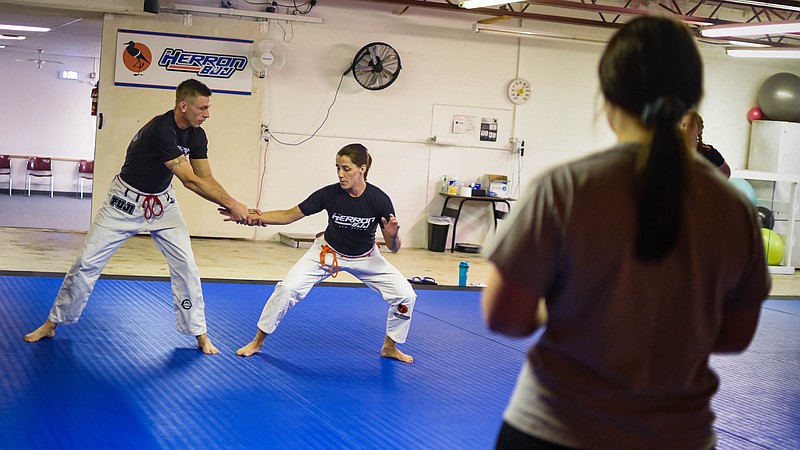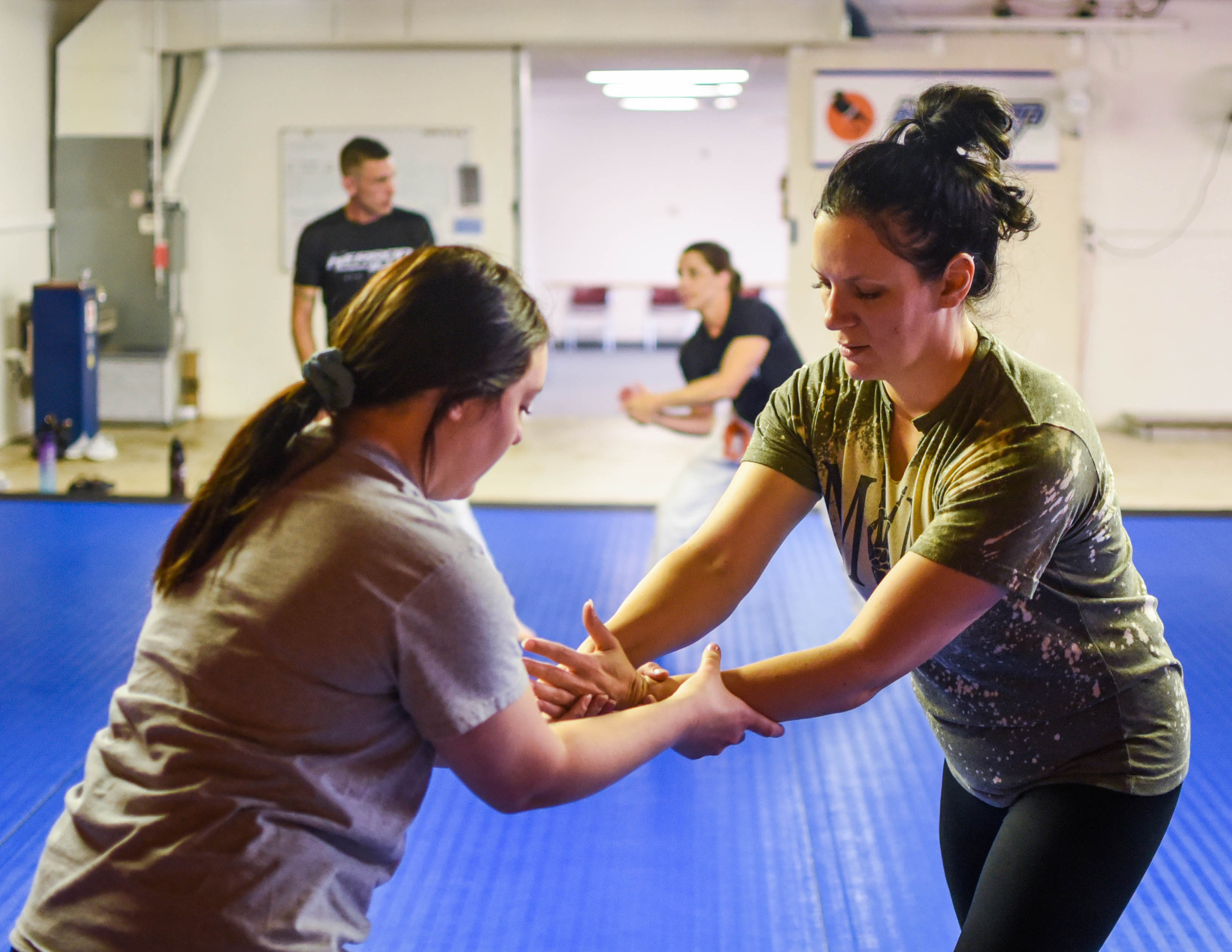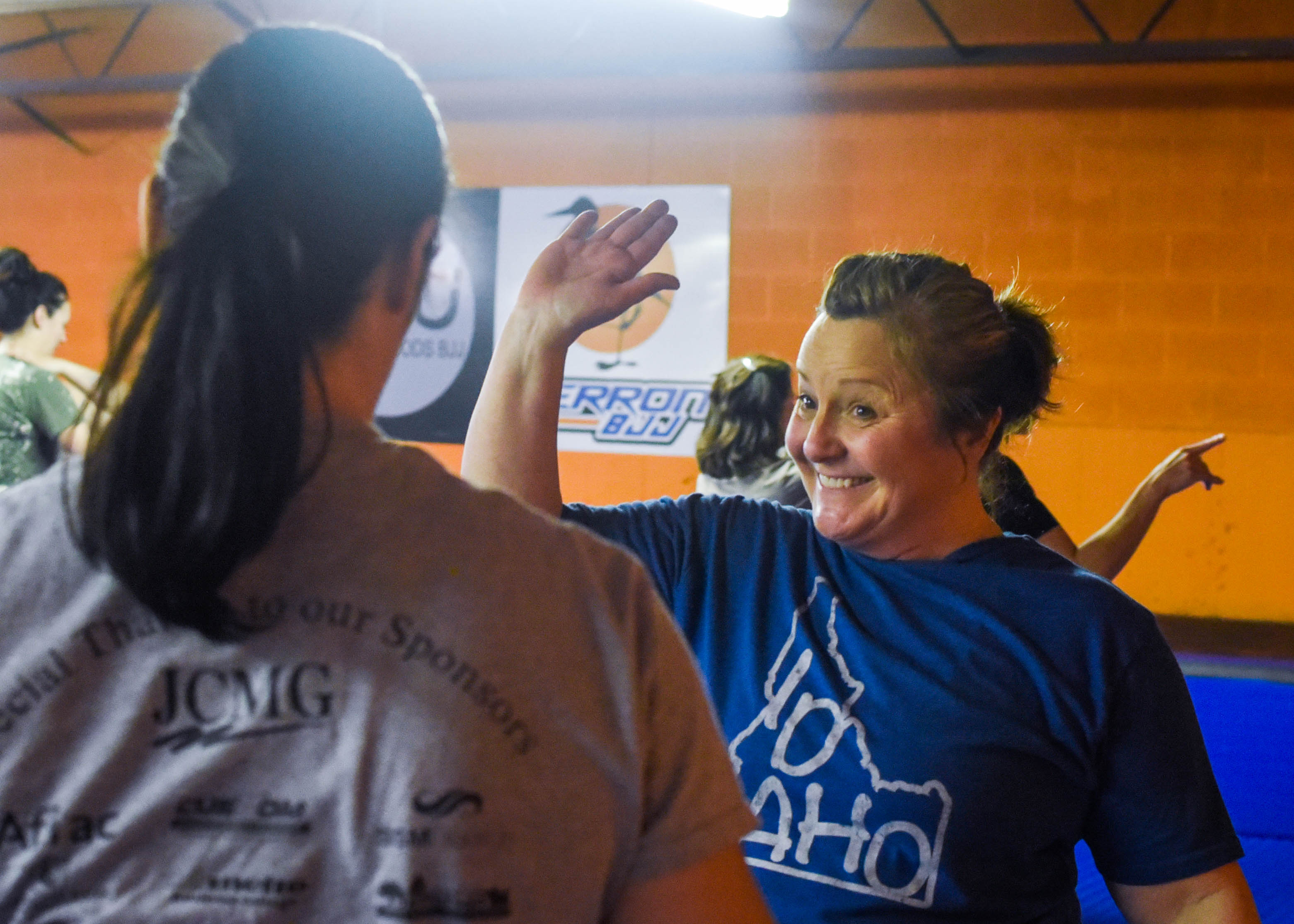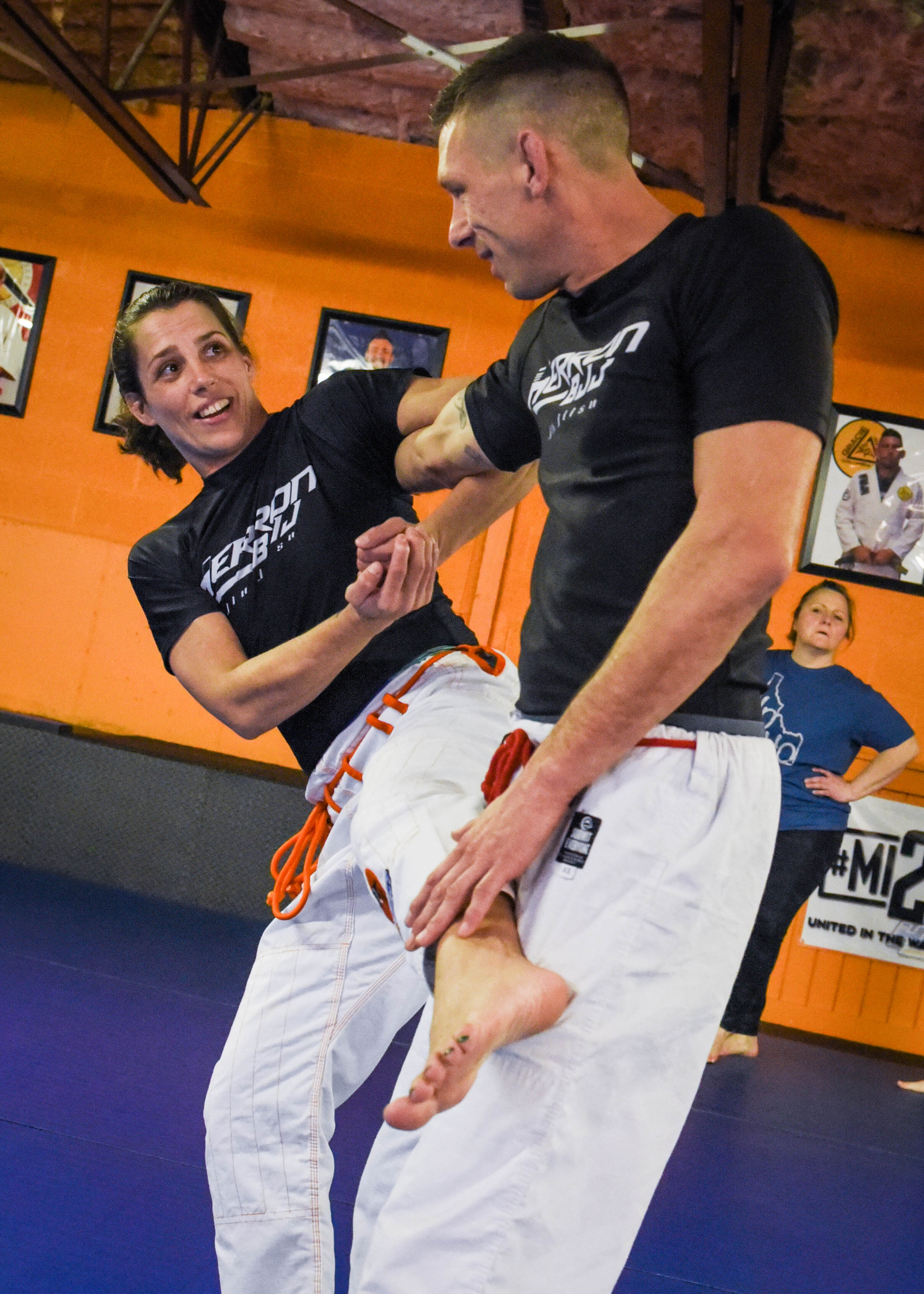Two women face each other; one tightly grabs the other’s wrists. There’s a moment of struggle and mental panic before the knowledge of how to escape kicks in.
“Plant your feet in a strong stance, act quickly, protect your face ...”
The victim is able to free herself from the two-handed hold, backing away with her hands up.
Then there’s a moment of celebration: A few women jump for joy when they master the escape.
It’s the women’s self-defense class held at HerronBJJ, and they’re learning how to defend against an attack.
“It’s just something good to have in your back pocket,” said Casey Rost, who attended with family members. “It makes you feel more comfortable because these days … it’s a scary world.”
For women, that can be especially true.
Sexual assault victims are more often female: One out of every six American women has been victim of attempted or completed rape in their lifetime, compared to one in every 33 American males, according to the Rape, Abuse & Incest National Network. And the number of female victims could be higher, as more than two out of three sexual assaults are not reported to the police.
Self-defense has offered a lot of hope — not just for the physical benefits but also the mental.
According to a 2014 University of Oregon study for women, self-defense works because those who participated in it “are less likely to experience assault and are more confident in their ability to effectively resist assault than similar people who have not taken such a class,” according to the World of Self-Defense. And since 70 percent of victims of rape know their assailant, according to the National Center on Domestic and Sexual Violence, self-defense can be crucial in teaching women how to trust to their instincts and protect themselves.
Getting a good foundation
The goal in self-defense is to not have to use it — often, voice and body language can scare off potential attackers — but if it does happen, these courses can be essential.
Cole County’s Rape Aggression Defense (R.A.D.) program offered by local law enforcement teaches women ways to defend against abduction, while spreading risk awareness and the mental preparedness it takes to avoid an attack.
The program — and others like it elsewhere — is a women-only course, with the only males being instructors. Deputy Joe Matherne, team leader for the Cole County R.A.D. program, said this is for the protection of the women in the course if they’ve experienced assault, but it’s also to prevent males from possibly building up strategies against these attacks.
“Our goal through the R.A.D. program is to provide women with a bunch of different tools for their tool belt,” Matherne said. “If (someone) is attacked in public, at least they have some knowledge to draw from. It provides them with the mindset, ‘I can defend myself.’ A lot of women want to but don’t know how to.”
R.A.D. students go through four class periods, with information in the first three and a fourth class period to try the techniques they learned. In everything, participants have the option to sit out of something if they don’t feel comfortable with it — as the course is a community program run by law enforcement, they bring up a lot of real-world scenarios that officers see every day.
“When you start talking about self-defense, rape aggression, kidnapping … it tends to get ‘doom and gloom,’” Matherne said. “It’s a serious matter, so we let them know the seriousness of the subject.”
But with information comes power: He said at the end of the course, the overwhelming feedback he’s received is that students feel more empowered. They recognize even if they encounter these situations, they at least know what to do.
He’s encouraged in hearing that it works, too: He was told by a student of a neighboring city’s R.A.D. program that she was able to defend herself when she was attacked on the street. She heard her instructors in her head saying, “Get in your base, get a good foundation,” and before she knew it, the man was lying injured on the ground.
R.A.D. students are able to walk away with the skills to stand confidently, verbally deter an attacker and practice moves with an instructor, but they also have a class period to try out these techniques. When they put on pads and get to the mat, Matherne and a fellow instructor encourage the student to hit them with all they’ve got — they will have formed that muscle memory in the case of an attack.
“It gives them the opportunity to put the moves to the test and show them these things do work,” he said. “Even with pads on, I walk away with bruises.”
Mentally ready
Matherne emphasizes in class a lesson he learned in law enforcement: “Your body can’t go where your mind has never been.”
Martial arts has become a popular avenue for developing mental and physical preparedness for self-defense scenarios. Brazilian jiu-jitsu (BJJ) has been on the rise since the 1990s, when fighters brought it to schools in the states. It became a national sport in 1994 under Carlos Gracie Jr., a pioneer in BJJ. As a sport, it emphasizes self-defense versus attack — but also prepares students to cause damage when in imminent danger.
After Janice and Clay Herron started jiu-jitsu training in Columbia, they were empowered not only by the skills they had gained but also the tight-knit community they found. They later founded HerronBJJ in Jefferson City to bring BJJ training closer to home.
Since founding their own martial arts school, they have offered a women-only class two nights a week, as well as women’s self-defense events four times a year. At their gym, most women are also part of the co-ed classes. In all their classes, they primarily focus on self-defense, teaching awareness of surroundings along with the skills needed to control a situation if it escalates.
“I feel it’s important for women because of the confidence it gives them,” instructor Janice Herron said. “That’s the biggest feedback, that they feel so empowered coming to the classes, learning ways to prevent attacks or help defend against attacks.”
Janice said once they try it, women tend to feel comfortable coming to lessons knowing they are around like-minded people with similar experiences, and they can trust her as a female instructor.
Still, she said getting more female students at their gym can be a struggle as the sport can be intimidating.
‘Create more power’
One reason for this might be the smaller ratio of women to men in martial arts, JC Crossfit co-founder Maria Holee observed. There is a statistical disparity among instructors: 21.2 percent of martial arts instructors are women, while 74.6 percent are men, according to job search website Zippia.
She has participated in martial arts training along with strength training at her business and points to societal pressures of women being a hindrance in both professions.
“It can be an anxious feeling trying something new, especially when you don’t see most women doing it,” Holee said, “but when you’ve completed it, that’s more empowering than just doing it physically.”
But local coaches and instructors are seeing a popularization in martial arts in recent years, and Holee said that number could change.
GracieBarra Jefferson City BJJ co-owner Oly Warner said at the last BJJ world summit, there was a large emphasis on women’s teams, and she saw seminars led by women, for women. Warner added some female gym owners have found they’ve attracted more students because more women are willing to try it.
She and her husband, Rob, have seen this at their gym — they will pair female students and coaches so the student is put more at ease.
It’s not that women aren’t wanting to learn self-defense, Holee said.
“With any type of thing that would be seen as a physical spot for women,” she said, it’s not that it’s impossible.
“It just hasn’t happened yet.”
Some aspects of being more prepared for self-defense require rewiring what women have been told about the way they should carry themselves, Holee said. If a potential attacker is looking at two women — one with a quiet position, more closed off, and the other in a dominant position with good posture — the less dominant position comes across as more vulnerable.
According to a National Center on Domestic and Sexual Violence study, women are conditioned to be polite and compliant toward men, but it’s important to “counter this conditioning.” Leaving yourself vulnerable gives you less of an opportunity to protect yourself.
“As a lady, you might be taught to walk ladylike, but from a self-defense perspective, your feet should be under your hips to where you could run and jump,” Holee said. “And (from an athletic perspective), you will perform activities better, build better muscle memory, create more power by using that power position.”
The emphasis across the board at local self-defense programs is that preparedness is key — anything could happen, so you have to recognize it could happen to you. The hope is to use your voice and stance to prevent it, but when your “spidey senses are tingling,” as Matherne calls it, that something more dangerous is ahead, you will have to act.
“When we get (attackers) into a control position, we get them down on the ground until help comes, so you don’t have to break or hurt anything,” Janice Herron said, “but there are scenarios where you’re gonna have to.”
The key is a confident stance and the confidence of knowing your next steps — the many ways you can defend yourself.
“The way (a woman) carries herself, even if it’s something as simple as making eye contact with somebody, could potentially avoid an attack,” Matherne said. “Even before you get into your moves, tell people ‘no’ or ‘stay back’ having that level of confidence in your voice. One of the big things is self-confidence.”
Stepping onto the mat
The mental and physical benefits are worth trying out self-defense, Holee said. The first step is showing up.
Janice Herron said their gym offers a free week’s trial to see if students enjoy it. And, bringing a friend could be what puts you more at ease about trying it.
“We recommend bringing a friend because it makes them more comfortable,” Herron said. “It’s always good to have someone you’re comfortable with in an uncomfortable situation.”
Also, think about the benefits that go beyond your self-defense skills. Holee said as women are subject to osteoporosis, sports that build bone density can also encourage lifelong health. Also, being in shape ensures you can physically handle a challenge in front of you.
For Matherne, he thinks about his family, and the peace that comes with knowing his wife could protect their children or herself if the situation arose. His oldest daughter has also taken the R.A.D. course.
“I always tell people my motivation for the class is not wanting my wife and kids to face that,” he said. “For people with their kids out in public, it’s not just about defending yourself but also defending your family.”
Rob and Oly Warner encourage students to stay in practice because your skills can be “perishable” — you can get out of practice in your techniques — and you want to maintain your stamina if an attack happens. They offer private lessons for those who are intimidated but encourage people to stay active regardless.
“Jiu-jitsu is for everyone, but until you get comfortable with it, find whatever keeps you fit to be able to have the stamina to fight back if necessary,” Oly Warner said.
Even if it’s intimidating, it’s completely possible.
“In the class, we encourage (students) that we all have — as humans, period — the ability to fight back or resist abduction or aggression,” Rob Warner said. “What we try to do is build on that natural ability and try to give you more confidence to perform and defend yourself. It’s better to have it and not need it.”




